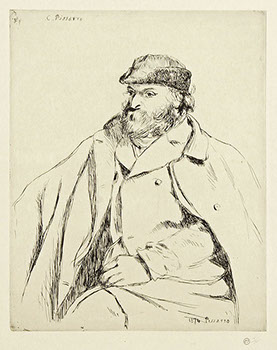Portrait of Paul Cézanne

1874
Delteil 13
Only state
Etching
10 1/2 x 8 1/2 in. (26.6 x 21.5 cm)
Price upon request
A very beautiful impression from the posthumous edition of 1920 on Japan paper numbered in pencil and with the artist’s ink stamp (Lugt 613f). Full margins.
Lifetime impressions of this important etching are extremely rare. According to Jean Cailac and Anne Röver, Pissarro made only about 20 impressions of this etching for his friends. Our impression is one of only 15 made on Japan paper out of a total of 75 posthumous numbered proofs (3 made in 1911 and 72 made in 1920).
Pissarro and Cézanne met for the first time in 1861. Cézanne had just moved to Paris from his native Provence. Pissarro was already established in Paris. The two artists developed a strong friendship that lasted about a quarter of a century. Although their relationship has often been described as the relationship of a master and his student because Pissarro was nine years older than Cézanne, the two artists actually viewed themselves as equals. They had a profound admiration for each other. They fought the same battles. They both rejected the dominance of the Salon and refused their art to be confined to any school. They often painted together, whether en plein air or in each other’s studios, sometimes choosing the same subject. Pissarro and Cézanne engaged in a long pictorial dialogue that changed the course of art history.
In 1872, Pissarro moved to Pontoise about 18 miles north-west of Paris. The same year, Cézanne moved nearby to Auvers-sur-Oise where Dr. Paul Gachet also lived. The same Gachet, who was the caretaker of Van Gogh in the final years of his life and the subject of a much revered portrait by the artist, was also a family doctor, a friend and an early collector of the Impressionists. He had some artistic talent as well: he etched under the pseudonym Van Ryssel and he even owned a printing press. Pissarro, Cézanne and Armand Guillaumin, who had also joined them, etched together in the studio of Gachet and used his printing press. The friends also did several portraits of each other.
This etched portrait of Cézanne relates to an oil portrait that Pissarro executed in early 1874. In both portraits, Cézanne is shown seated, looking away, wearing a distinctive hat and a large shepherd’s overcoat, his winter accoutrement. The position of the sitter is reversed in the etching, suggesting that it was executed after the painting. Although the two artists ended their relationship in 1885, Pissarro kept the oil portrait in his studio until his death, a testament of his continued affection and admiration for Cézanne The same portrait now can be seen at the National Gallery, London where it is on loan from the collection of the jeweler Laurence Graff
Probably encouraged by Gachet, Pissarro had just returned to printmaking when he etched the portrait of Cézanne. He had made several small, sketch-like landscapes around Pontoise etched directly on the plate ('croquis sur cuivre'). Pissarro reworked and printed those plates in the studio of Gachet. The etched portrait of Cézanne, also in pure line, is a simplified transposition of the portrait in oil. The newspaper sheets featuring cartoons of the politician Adolphe Thiers and Gustave Courbet and the little oil painting by Pissarro hanging behind the sitter are absent from the etching. What is left is just the imposing figure of Cézanne – Pissarro substituted the oversized overcoat for the oversized head of the oil portrait - and his piercing, small, dark eyes full of determination and assurance.
Put side by side, the two portraits show the whole of the complex personality of Cézanne and the relationship between the two artists. The disproportionately big head of Cézanne, his chubby cheeks, his prominent beard, his huge hands give the oil portrait a cartoonesque air, echoing the caricatures hanging on the wall behind the sitter. This was possibly Pissarro’s way of jokingly predicting the fame awaiting his friend. The oil portrait conveys the close friendship between the two artists and the softer, endearing side of Cézanne's otherwise tempestuous character.
The simple, spontaneous etching, likely directed adapted from the oil portrait to the copper plate, is more serious and reverential. Almost devoid of any modeling and any tonal values, consisting of just a few etched lines that get sharper, denser and more angular around the face, the etched portrait convincingly conveys the strong character of Cézanne and Pissarro’s admiration for his colleague.
Pissarro's etched portrait of Paul Cézanne is a superb early example of an etching depicting a human figure executed in pure line. This etching foreshadows the modernist, linear etchings of Picasso and Matisse that shook up printmaking in the following century.
Literature:
B. S. Shapiro, 'Camille Pissarro, The Impressionist Printmaker', Boston, 1973.
A. Röver, 'Camille Pissarro, Radierungen, Lithographien, Monotypien aus deutschen und oesterreichischen Sammlungen', Bremen, 1990.
L. Delteil, J. Cailac, A. Hyman, 'Camille Pissarro, L’Oeuvre Gravé et Lithographié, The Etchings and Lithographs, Catalogue Raisonné', San Francisco, 1999.
J. Pissarro et al., 'Cézanne et Pissarro 1865-1885', Paris, 2005.
© 2017 Roulot Fine Prints LLC. All Rights Reserved.